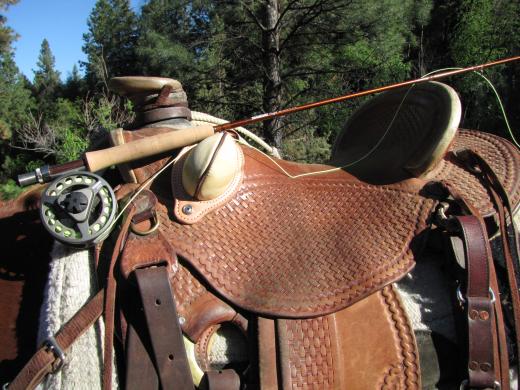Green Broke
by Mark Bagett
“I’m-getting –too-old-for-this...”
My utterance had a strained, staccato cadence and was laced with enough expletives to warm even the most frost-stung ears that morning. The little paint filly had taken a half-dozen deceptively quiet steps and then all but broke in half, jumping and firing at a much faster pace than I could begin to process. I took little consolation that our diminutive rodeo was set in a lush (read soft) mountain park rather than the trailhead parking lot; that much had been by design. Because, well, I’m getting too old for that.
Too old for indulging the creative imaginations of green-broke ponies, perhaps, but certainly not for clawing my way into a comfortable saddle and trotting deep into the backcountry. How I managed to avoid a new role as a human yard dart that morning remains a mystery, but I can tell you it wasn’t through any measure of elegance—a notion I’m sure the gent who was with me that day would quickly affirm. At any rate, as abruptly as she started, the little filly decided she’d warmed up enough and settled into a smug walk, so my biologist pal and I pointed our steeds into the bowels of Oregon’s North Fork John Day Wilderness.
Our goal that day was to scout a potential trail to horse-pack supplies into a crew that was working their way up the wildest reaches of the North Fork John Day River, performing native salmon surveys.

Though there was a time I rather enjoyed starting colts, riding young horses has typically been more a function of affordability than preference for me. But that morning I began to realize that if I hoped to continue jostling cattle and enjoying the wild places I love from the back of a pony, I’d better think about digging a bit deeper behind my Ws and adjusting my equine program to feature well-broke (hell, even bomb proof) horses. And someday I will.
Transition often doesn’t come easily but it nonetheless comes for everyone at some point. While motorized recreation remains ever popular among younger and family-aged participants on our public lands, yet another very interesting demographic has emerged over the past couple of decades. These are the retirement-age and older outdoorsmen who have spent the better part of their lives in the woods or wild places; the types who once thought nothing of spending three days on a bull elk track with nothing more than their rifle and a rucksack. More significantly, they were some who grew most concerned 30 to 40 years ago when new roads were stacking up our mountainsides like laces up a logging boot.
Nowadays these folks, or many of them, have transitioned to ATVs or UTVs to keep them connected to their favorite haunts, and they’re looking to some of the same road infrastructure they once bemoaned to make that happen. From a sportsmen’s perspective, these are among the ambassadors we should be recruiting to represent us in our forest travel management talks. They’re not thrill riders or ground slashers. They are keenly aware of the impact that high road densities can have on fish and wildlife populations, and they are vested in maintaining suitable access. For more along those lines, be sure to check out the coalition, Sportsmen Ride Right and then share that information with the transitioning outdoorsman you’re thinking of right now.
Me, I’m still aiming for bomb proof.
For more on the Summer Blog Series head over to the Our Sporting Heritage Site.


